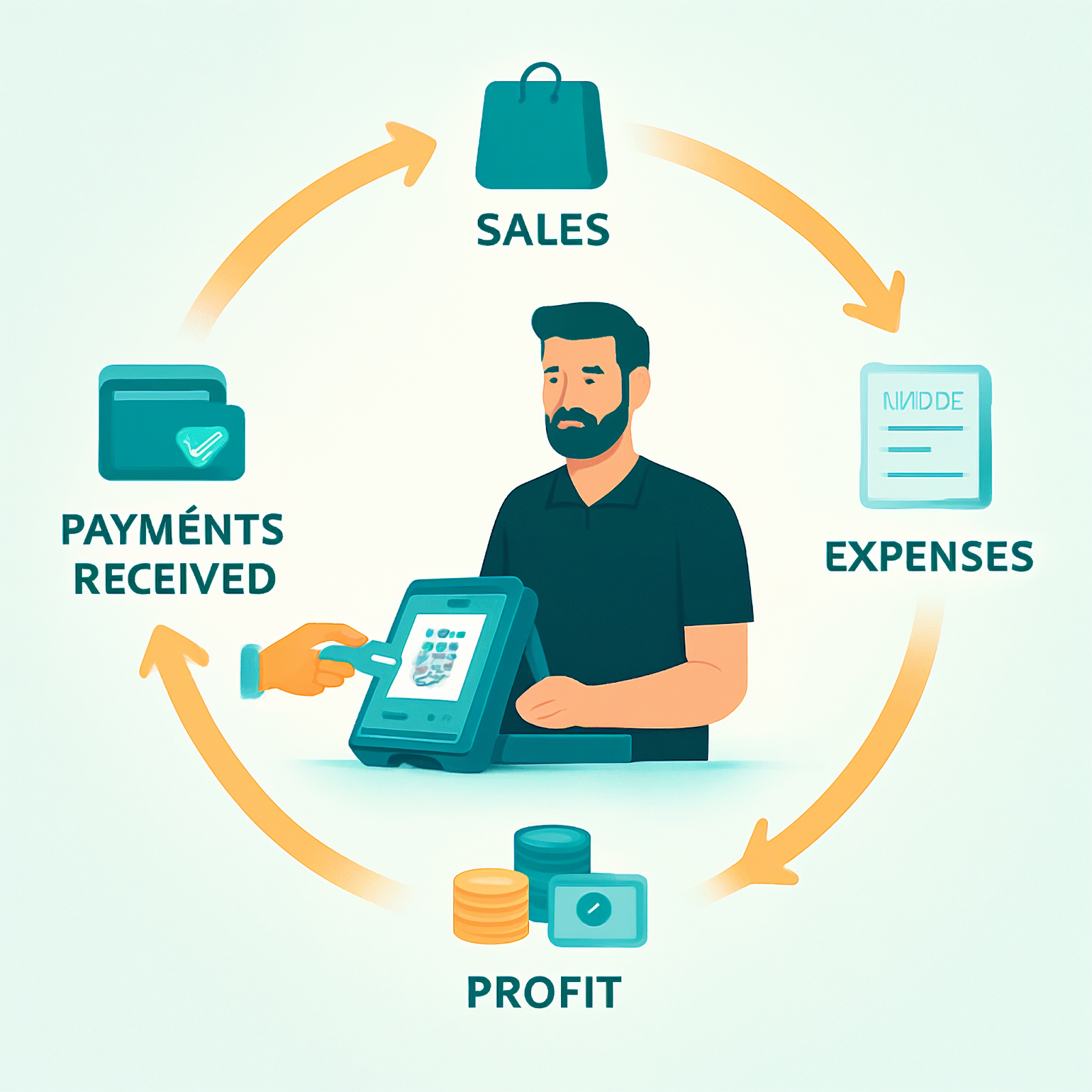Top 10 Challenges Small Businesses Face in 2025 (and How to Overcome Them)

Running a small business is exciting — but it’s also exhausting. You’re the CEO, accountant, HR, and customer service team, all rolled into one.
Between rising costs, late payments, staffing struggles, and endless operational issues, most days feel like a race just to keep up. And yet, millions of small-business owners wake up and do it all over again, because the dream is worth it.
As we approach Small Business Saturday 2025, we’re shining a light on the people behind those dreams and the real obstacles they face (and overcome) every day. This blog post explores the biggest challenges faced by small businesses, and how practical systems and the right tools can turn those challenges into everyday wins.
1. Rising Costs, Shrinking Margins
Inflation has been relentless. The cost of rent, raw materials, packaging, and labor has climbed across industries. You can’t raise prices every month, but ignoring it eats away at your profit.
What you can do
- Track your margins in real time. Use your POS or accounting tool to monitor profitability and spot problems early.
- Rework your pricing mix. Create value combos or bundle slow-moving items with popular ones.
- Negotiate with suppliers. Long-term loyalty often gets you better deals than constant switching.
- Communicate openly. Customers respect honesty more than sudden price jumps.
The silver lining
Customers don’t always chase the lowest price, they value consistency and transparency. If your product quality and service stay strong, loyalty follows even in tough times.
2. Cash Flow Headaches
Your store might be busy, but if payments arrive late, bills pile up fast. Cash flow gaps are one of the biggest reasons small businesses struggle, even when sales are good.

What you can do
- Accept every form of payment. Cards, digital wallets, and QR options speed up collections.
- Invoice faster, get paid faster. Automate invoicing and reminders to save time.
- Reward early payers. Offer small discounts for on-time payments.
- Build a cash cushion. Keep at least one month’s expenses aside for emergencies.
The silver lining
Once you control your cash inflows and automate reminders, your finances stop running you — you start running them.
3. Finding and Keeping Customers
Attracting customers is costly; keeping them is harder. Competition is everywhere — online and offline. And marketing budgets can only stretch so far.
What you can do
- Capture customer details at checkout. Use that data to personalize future offers.
- Set up loyalty rewards. Reward repeat visits with points or small perks.
- Ask for feedback. Positive reviews on Google or Instagram can bring in new footfalls.
- Keep it personal. A quick WhatsApp message or friendly note often beats a flashy ad.
The silver lining
Your best marketing asset isn’t paid ads—it’s happy customers who keep coming back (and bring their friends along).
4. Managing Inventory Without Losing Sleep
Inventory is a balancing act. Too little stock, and you lose sales. Too much, and your cash sits idle. Manual stock tracking often leads to both.
What you can do
- Switch to real-time tracking. A POS system can show you what’s moving fastest and what’s gathering dust.
- Set alerts for reorders. Never get caught off-guard with stockouts.
- Focus on “A” items. Give most of your attention to the products that generate the highest profit.
- Run smart promotions. Bundle slow-moving stock with crowd favorites.
The silver lining
When your inventory is managed by data — not guesswork — you reduce waste, improve cash flow, and serve customers more reliably.
5. Hiring, Training, and Retaining the Right People
Finding good employees and keeping them is one of the toughest challenges in retail and hospitality. Staff turnover hurts productivity, service quality, and morale.

What you can do
- Plan staffing smartly. Use POS sales data to predict peak hours and plan shifts efficiently.
- Make training easy. Create short, clear video tutorials for daily tasks.
- Recognize performance. A small bonus or shout-out can boost motivation.
- Automate repetitive tasks. Reduce pressure on your staff during rush hours with handheld POS devices or kiosks.
The silver lining
When your team feels trusted, trained, and valued, they stay longer—and customers notice the difference immediately.
6. Access to Capital and Funding
You might have a great business, but getting a loan to expand or survive a lean month can feel impossible. Traditional banks still rely on long credit histories or heavy documentation.
What you can do
- Use your sales data as proof. Many fintech lenders accept POS transaction data for faster approvals.
- Match the loan to your needs. Short-term loans for inventory; long-term ones for upgrades.
- Stay organized. Clean books and consistent records make borrowing easier.
- Borrow wisely. Always plan for repayments based on your slowest sales month.
The silver lining
Access to funding is improving. Data-backed businesses are now getting approved faster. and often at better terms than ever before.
7. Having Trouble Standing Out in the Market
The problem
Competition isn’t just about pricing — it’s about perception. Established players often have stronger brand recall, bigger marketing budgets, and loyal customer bases. Without a clear differentiator, small businesses risk blending into the background.
What you can do
- Define your unique value proposition. What makes your business different — product quality, customer experience, or community connection?
- Tell your story. People love authenticity. Share the “why” behind your brand through social media and local partnerships.
- Focus on niche marketing. It’s easier to dominate a small, defined segment than to compete with everyone.
- Leverage digital presence. Use Google My Business, reviews, and social proof to build trust and visibility.
The silver lining
You don’t need the biggest budget to stand out — just the clearest message. Customers connect with real stories, consistent experiences, and brands that feel human.
8. Losing Your Passion for the Business
The problem
When you first start out, excitement fuels you. But over time, managing operations, finances, and staff can take its toll. Burnout creeps in, and what once felt thrilling can start to feel like a routine.
What you can do
- Reconnect with your “why.” Remember what made you start this journey. Revisit old goals and celebrate progress.
- Delegate smarter. Free yourself from repetitive tasks using automation or a capable team.
- Keep learning. Attend workshops, network with peers, and explore new ideas to keep things fresh.
- Take breaks. Rest isn’t wasted time — it’s fuel for creativity and clarity.
The silver lining
Passion isn’t constant — it’s cyclical. With the right balance of systems and self-care, it always finds its way back.
9. Pivoting to a New Business Model
The problem
Markets change fast — sometimes overnight. The pandemic proved that even stable businesses must be ready to adapt. You might need to introduce new services, move online, or reimagine your entire model.
What you can do
- Stay flexible. Regularly review what’s working and what isn’t.
- Listen to customers. Their evolving needs often hint at the right direction.
- Start small. Test new products or delivery models before scaling them.
- Leverage digital tools. Use online ordering, delivery integrations, or e-commerce to stay accessible.
The silver lining
Change doesn’t always mean loss — it can mean evolution. The most resilient businesses don’t resist change; they reinvent themselves through it.
10. Overreliance on a Small Stable of Customers
The problem
Loyal customers are the backbone of any small business — but relying too heavily on a few can be risky. If one major client leaves or regulars stop coming, revenue can drop overnight.
What you can do
- Diversify your customer base. Explore new demographics or channels (online sales, delivery apps, or local events).
- Ask for referrals. Happy customers often bring others.
- Expand your offerings. Introduce seasonal products, add-on services, or loyalty programs to reach new segments.
- Keep marketing even when you’re busy. Consistent visibility ensures a steady flow of new customers.
The silver lining
A broader customer base builds long-term stability. By innovating and expanding thoughtfully, you can create a business that thrives — not one that survives client to client.
How Successful Small Businesses Overcome Challenges
Every small business faces challenges and obstacles — rising costs, cash flow issues, staffing headaches, or just the daily grind of keeping things running. The difference between those that survive and those that thrive often comes down to how they handle these challenges.
Successful business owners don’t aim for a problem-free journey, they aim for a predictable one. They know that challenges will always exist, so instead of reacting to each fire, they build systems that help prevent them in the first place.
They set up clear processes, automate routine tasks, and rely on data instead of guesswork. They track what’s working, fix what’s not, and use those insights to grow steadily, not sporadically.
Most importantly, they embrace technology as a business partner, not a burden. From managing inventory to tracking sales or understanding customer behavior, modern tools help them stay ahead of the curve, even when the market isn’t in their favor.
Technology: The Secret Weapon of Modern Entrepreneurs
A lot of small-business owners still hesitate to invest in technology, thinking it’s too expensive or complicated. But today’s tools aren’t built to overwhelm — they’re built to simplify.

Even a single upgrade, like adding a modern POS system, can transform how you run your business. It can:
- Unify your operations: bring sales, payments, and inventory together in one dashboard.
- Give you visibility: track which products are performing best in real time.
- Simplify payments: accept cards, tap, QR, or digital wallets without the hassle.
- Build loyalty: use customer data to create personalized rewards and offers.
- Scale easily: manage multiple stores or outlets from anywhere.
With the right tech in place, you don’t just work harder — you work smarter.
Why it matters
Technology doesn’t replace your hard work — it amplifies it. It frees up your time and energy for what matters most: growing your business.
How OneHubPOS Helps Small Businesses Stay Ahead
At OneHubPOS, we understand that small businesses don’t just need another POS — they need a partner that makes operations effortless.
Here’s how we help:
- Fast setup: you can go live in hours, not days.
- One platform for all payments: card, cash, or QR.
- Smarter inventory tracking: with real-time alerts and analytics.
- Built-in customer insights: to personalize experiences and drive repeat sales.
- Multi-store management: for businesses ready to expand.
Whether you run a café, restaurant, or retail store, OneHubPOS brings everything together, so you can focus less on problems and more on progress.
👉 Book a free 30-minute demo to see how OneHubPOS can simplify your business.
Frequently Asked Questions
In 2025, small businesses continue to face rising operational costs, cash flow gaps, talent shortages, and increased competition. Many also struggle with standing out in crowded markets, keeping their passion alive, and adapting to new business models as consumer behavior evolves.
Start by accepting multiple payment options — cards, QR codes, and digital wallets — to speed up collections. Automate invoicing and reminders to save time, and maintain a cash buffer for emergencies. Using a modern POS system also gives you real-time visibility into your sales and expenses, making cash flow easier to predict and manage.
Define what makes your business unique — whether it’s product quality, personalized service, or a local connection. Tell your story consistently across digital and offline channels, and focus on delivering exceptional customer experiences. Even without a huge marketing budget, authenticity and reliability can make your business memorable.
Reconnect with your original “why.” Celebrate small wins, delegate routine tasks, and take short breaks when needed. Surround yourself with a supportive network of peers and mentors. Many owners also use automation tools to free up time for creative and strategic work — which helps keep the spark alive.
Technology simplifies everyday operations. A good POS system can unify sales, payments, and inventory on one dashboard, track real-time profitability, and help you understand your customers better. This makes decision-making faster, reduces errors, and allows business owners to focus more on growth instead of admin work.
Small Business Saturday is an annual event that encourages consumers to support local, independent businesses. It gives small business owners a valuable spotlight — boosting sales, visibility, and community engagement. It’s also a reminder that small businesses are the heart of every neighborhood and deserve year-round support.
Rajat is a growth marketing professional with a passion for creating content that drives engagement and measurable results. He specializes in turning insights into clear, actionable stories that help brands scale.


